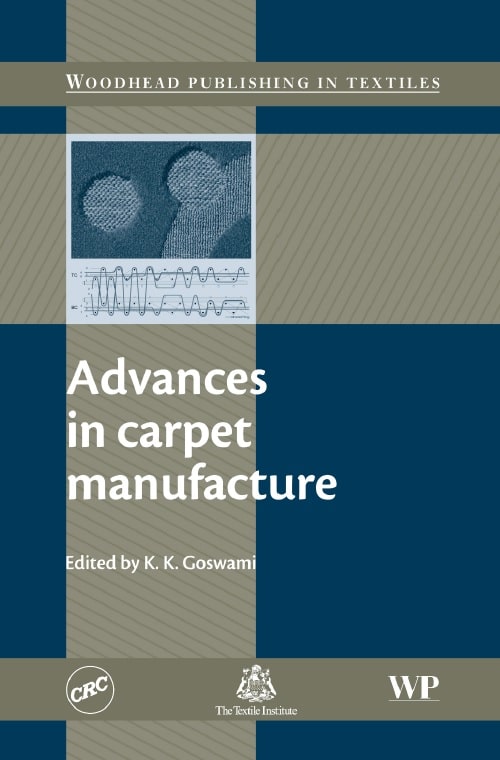
Contents
Contributor contact details ix
Woodhead Publishing in Textiles xi
1 Carpet types and requirements 1
D WHITEFOOT, CText, FTI, UK
1.1 The role of textiles in floor coverings 1
1.2 Types of textile used as floor coverings 5
1.3 Methods of carpet construction 11
1.4 Future trends 17
1.5 Sources of further information and advice 18
2 Structure and properties of carpet fibres and yarns 19
S K CHAUDHURI and S BANDYOPADHYAY,
Australian Wool Innovation, India
2.1 Introduction 19
2.2 Structure and properties of carpet fibres 20
2.3 Carpet yarn manufacturing 27
2.4 Carpet yarn engineering 33
2.5 Yarn finishing 38
2.6 Carpet yarn testing and quality control 42
2.7 Future trends 43
2.8 Sources of further information and advice 43
2.9 References 43
3 Advances in carpet weaving 44
S DEMEY, N V Michel Van de Wiele, Belgium
3.1 Introduction 44
3.2 Face-to-face carpet weaving 45
3.3 Axminster weaving 58
3.4 Wire Wilton and loop pile weaving 61
3.5 Automation in carpet-weaving mills 64
3.6 Management of carpet-weaving factory 68
3.7 Conclusions 75
4 Developments in wool carpet manufacture 77
E J WO O D , AgResearch Ltd, New Zealand
4.1 Introduction 77
4.2 Wool supply and early stage processing 79
4.3 Processing routes for wool 82
4.4 Technologies for wool carpet yarns 83
4.5 Manufacturing techniques for wool carpets 87
4.6 Technologies for tufting wool carpets 87
4.7 Wool carpet performance 93
4.8 Selecting the most appropriate wool carpet 96
4.9 Future trends 96
4.10 Sources of further information and advice 99
4.11 References 100
5 Developments in textile sports surfaces 102
G S C H O U K E N S , Ghent University, Belgium
5.1 Introduction 102
5.2 Key requirements of sports surfaces 104
5.3 Types of textiles used in relation to the sports surfaces 104
5.4 Role of textiles in meeting performance requirements 106
5.5 Sliding and temperature, related to the used textiles 119
5.6 Future trends 128
5.7 Applications and examples of artificial turf fields 130
5.8 Acknowledgements 135
5.9 References 135
6 Developments in handmade carpets: introduction 138
K K GO SWAMI , Indian Institute of Carpet Technology, India
6.1 Introduction 138
6.2 The history of handmade carpets 139
6.3 Modern handmade carpet production 143
6.4 Carpet production in India 144
6.5 Carpet production in Iran 148
6.6 Carpet production in China 150
6.7 Carpet production in Pakistan 151
6.8 Carpet production in Nepal 152
6.9 Carpet production in Turkey 152
6.10 Carpet production in Europe 154
6.11 The international trade in carpets 156
6.12 Terminology in carpet production 165
6.13 The role of handmade carpets in modern carpet production 165
6.14 Choosing and maintaining a handmade carpet 169
6.15 Acknowledgements 171
6.16 References 172
Appendix: terminology relating to handmade carpets 173
7 Developments in handmade carpets: design and manufacture 182
K K GO SWAMI , Indian Institute of Carpet Technology, India
7.1 Introduction: key issues in design 182
7.2 Traditional carpet designs 183
7.3 Key stages in design 198
7.4 Carpet materials 200
7.5 Sheep wool 200
7.6 Silk 206
7.7 Cotton 208
7.8 Other natural fibres 208
7.9 Synthetic fibres 210
7.10 Backing materials 211
7.11 Manufacturing techniques 212
7.12 Key terms in manufacturing 229
7.13 Weaving of handmade carpets 230
7.14 Carpet knots 237
7.15 Dyeing 240
7.16 Dyeing of wool 240
7.17 Chemical processing and dyeing of silk 252
7.18 Natural colours for wool and silk carpets 255
7.19 Eco-friendly and organic carpet manufacture 259
7.20 Colour matching 260
7.21 Quality issues 261
7.22 Customer attitudes to quality 264
7.23 Acknowledgements 267
7.24 References 268
8 Reducing static electricity in carpets 269
J SMA L LWO O D , Electrostatic Solutions Ltd, UK
8.1 Introduction 269
8.2 Principles of static electricity in carpeted environments 270
8.3 Methods of reducing static electricity in carpet materials 280
8.4 Test methods and standards 281
8.5 Applications 286
8.6 Future trends 288
8.7 Sources of further information and advice 288
8.8 Acknowledgement 289
8.9 References and further reading 289
9 Developments in the thermal processing of carpets 291
W CA R R and H DO N G , Georgia Institute of Technology, USA
and H S L E E , Cerro Flow Products, Inc., USA
9.1 Introduction 291
9.2 Carpet yarn twist setting 293
9.3 Carpet dyeing and finishing 297
9.4 Carpet drying after dyeing and finishing 301
9.5 Latex curing 305
9.6 Energy consumption and management 307
9.7 Future trends 309
9.8 References 309
